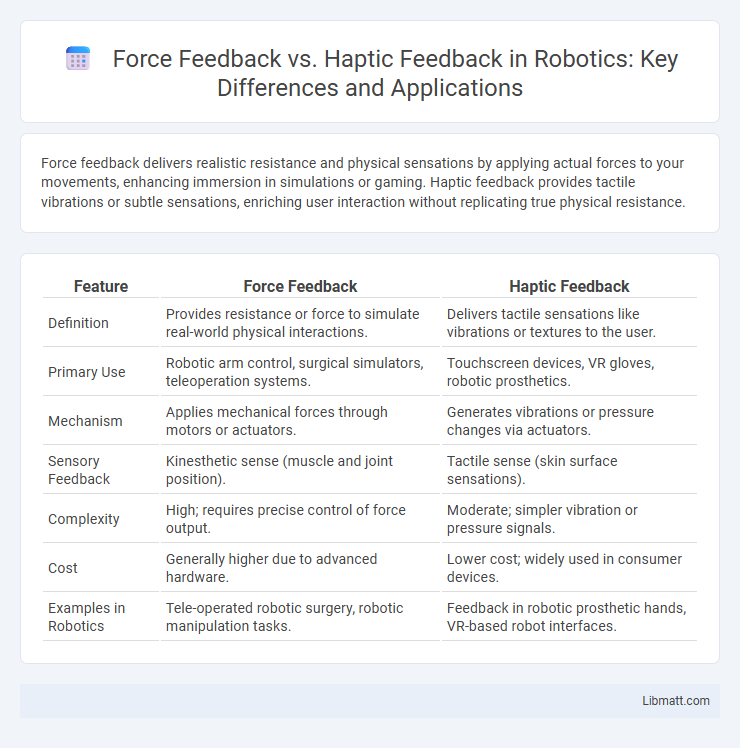Force feedback delivers realistic resistance and physical sensations by applying actual forces to your movements, enhancing immersion in simulations or gaming. Haptic feedback provides tactile vibrations or subtle sensations, enriching user interaction without replicating true physical resistance.
Table of Comparison
| Feature | Force Feedback | Haptic Feedback |
|---|---|---|
| Definition | Provides resistance or force to simulate real-world physical interactions. | Delivers tactile sensations like vibrations or textures to the user. |
| Primary Use | Robotic arm control, surgical simulators, teleoperation systems. | Touchscreen devices, VR gloves, robotic prosthetics. |
| Mechanism | Applies mechanical forces through motors or actuators. | Generates vibrations or pressure changes via actuators. |
| Sensory Feedback | Kinesthetic sense (muscle and joint position). | Tactile sense (skin surface sensations). |
| Complexity | High; requires precise control of force output. | Moderate; simpler vibration or pressure signals. |
| Cost | Generally higher due to advanced hardware. | Lower cost; widely used in consumer devices. |
| Examples in Robotics | Tele-operated robotic surgery, robotic manipulation tasks. | Feedback in robotic prosthetic hands, VR-based robot interfaces. |
Understanding Force Feedback and Haptic Feedback
Force feedback provides realistic physical resistance and forces in devices like steering wheels or joysticks, enhancing immersion by simulating real-world interactions. Haptic feedback delivers tactile sensations through vibrations or pulses, allowing you to perceive textures or alerts on touchscreens and controllers. Understanding these technologies helps improve user experience by aligning sensory input with virtual or digital interactions.
Key Differences Between Force Feedback and Haptic Feedback
Force feedback provides physical resistance or force to simulate real-world interactions, commonly used in steering wheels and flight simulators to enhance realism and control precision. Haptic feedback delivers tactile sensations through vibrations or pulses to convey information or alerts, widely found in smartphones and wearable devices for user interaction cues. The key difference lies in force feedback replicating actual forces acting on the user, while haptic feedback primarily offers sensory feedback without resistance or physical force.
The Technology Behind Force Feedback
Force feedback technology uses motors and sensors to simulate real-world physical forces, providing resistive forces that mimic weight, texture, and impact in gaming and simulation devices. This contrasts with haptic feedback, which primarily employs vibrations or tactile cues to enhance user experience. Force feedback systems integrate real-time data to dynamically adjust resistance, offering a more immersive and realistic interaction that can greatly enhance your control sensitivity and precision.
How Haptic Feedback Works
Haptic feedback works by using actuators or motors to simulate touch sensations, enabling users to feel vibrations, textures, or pressure through a device. This technology translates digital signals into tactile responses, enhancing the realism of virtual interactions by mimicking real-world physical sensations. Unlike force feedback, which applies resistance to mimic forces, haptic feedback emphasizes subtle vibrations and touch cues for sensory immersion.
Applications of Force Feedback in Modern Devices
Force feedback technology enhances user experience by providing realistic resistance and tactile sensations in devices such as gaming controllers, steering wheels, and flight simulators. Medical training tools employ force feedback to simulate precise instrument resistance, improving skill acquisition in minimally invasive surgeries. Industrial robots and virtual reality systems integrate force feedback to enable precise manipulation and immersive interaction, increasing efficiency and user immersion.
Haptic Feedback in Everyday Technology
Haptic feedback enhances user experience by providing tactile sensations through vibrations or forces in everyday technology such as smartphones, gaming controllers, and wearable devices. Unlike force feedback, which simulates physical resistance primarily in specialized equipment like steering wheels or flight simulators, haptic feedback is widely integrated to improve touch interaction and alert notifications. This technology relies on actuators to create precise sensations, increasing device usability and immersive interaction in daily applications.
Advantages of Force Feedback Systems
Force feedback systems provide precise tactile sensations by simulating real-world forces, enhancing the realism and immersion in applications like flight simulators and virtual reality. These systems enable users to experience resistance and texture variations, improving control accuracy and situational awareness. Your interaction benefits from this heightened sensory input, making tasks more intuitive and reducing errors.
Benefits and Limitations of Haptic Feedback
Haptic feedback offers immersive sensations by simulating touch, vibration, and texture, enhancing user experience in gaming, virtual reality, and medical training. Its benefits include improved spatial awareness and fine motor control, but limitations involve restricted feedback complexity and dependence on hardware quality. Your interaction effectiveness may be reduced if the haptic feedback device lacks precision or responsiveness compared to force feedback systems.
Choosing Between Force Feedback and Haptic Feedback
Choosing between force feedback and haptic feedback depends on the level of immersion and realism you desire in your interactive experience. Force feedback provides resistance and physical sensations that mimic real-world forces, ideal for simulators and gaming environments requiring precise control. Haptic feedback enhances tactile interaction through vibrations and subtle touch sensations, making it suitable for mobile devices and casual applications where nuanced touch response improves usability.
Future Trends in Tactile Feedback Technologies
Future trends in tactile feedback technologies emphasize the integration of force feedback and haptic feedback to create more immersive and realistic user experiences. Advances in materials science and sensor technology are enabling devices to deliver precise force feedback that simulates physical resistance alongside nuanced haptic vibrations for detailed texture sensations. Your interactions with virtual environments will increasingly benefit from these innovations, enhancing realism in gaming, remote surgery, and virtual training applications.
Force Feedback vs Haptic Feedback Infographic

 libmatt.com
libmatt.com